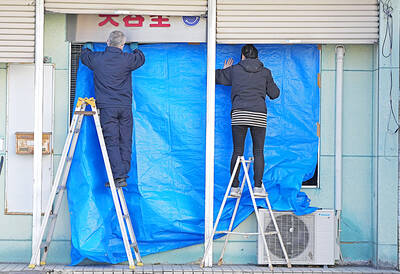Civic environmental groups yesterday staged a protest at the Environmental Protection Administration in Taipei to call for Formosa Plastics Corp’s naphtha cracker in Mailiao Township (麥寮), Yunlin County, to arrange its own water supply instead of using water meant for irrigating farms during the dry season.
An ad hoc environmental impact assessment (EIA) meeting was held five years ago to review the possible environmental impact caused by the cracker’s proposed plan to meet its water usage needs. The plan entailed collecting used water from the end of an irrigation canal derived from the Sinhuwei River (新虎尾溪).
The Taiwan Water Conservation Alliance said that an EIA committee that reviewed the cracker’s 4.3-phase expansion project in 2007 had asked the plant to come up with a way to be self-sufficient in its water supply so as not to deprive the surrounding farms of too much water.
The solutions proposed by Formosa Plastics were reviewed by the agency two years ago, but the plant is still having difficulties meeting its water needs, said Wu Li-huei (吳麗慧) of the Taiwan Environmental Protection Union’s Changhua Office.
Wu urged the company on behalf of the union to invest in technologies such as seawater desalination to supply the cracker with the water it needs and leave the fresh water to be used by locals and farmers.
Yunlin County Environmental Protection Union chairman Chang Tsu-chien (張子見) said that during the dry season — which typically lasts from February to May — between 40 percent and 90 percent of the water used by the cracker is meant to be used for irrigation.
Using groundwater in the dry season causes land subsidence, so the government should immediately force the plant to implement a new water supply plan, Chang said.
Changhua Medical Alliance for Public Affairs consultant Yang Joe-ming (楊澤民) said that forcing the plant to acquire its own water supply is the only way that it will invest in state-of-the-art environmental engineering technology and leave the fresh water available for farming purposes.

Taiwanese were praised for their composure after a video filmed by Taiwanese tourists capturing the moment a magnitude 7.5 earthquake struck Japan’s Aomori Prefecture went viral on social media. The video shows a hotel room shaking violently amid Monday’s quake, with objects falling to the ground. Two Taiwanese began filming with their mobile phones, while two others held the sides of a TV to prevent it from falling. When the shaking stopped, the pair calmly took down the TV and laid it flat on a tatami mat, the video shows. The video also captured the group talking about the safety of their companions bathing

US climber Alex Honnold is to attempt to scale Taipei 101 without a rope and harness in a live Netflix special on Jan. 24, the streaming platform announced on Wednesday. Accounting for the time difference, the two-hour broadcast of Honnold’s climb, called Skyscraper Live, is to air on Jan. 23 in the US, Netflix said in a statement. Honnold, 40, was the first person ever to free solo climb the 900m El Capitan rock formation in Yosemite National Park — a feat that was recorded and later made into the 2018 documentary film Free Solo. Netflix previewed Skyscraper Live in October, after videos

Starting on Jan. 1, YouBike riders must have insurance to use the service, and a six-month trial of NT$5 coupons under certain conditions would be implemented to balance bike shortages, a joint statement from transportation departments across Taipei, New Taipei City and Taoyuan announced yesterday. The rental bike system operator said that coupons would be offered to riders to rent bikes from full stations, for riders who take out an electric-assisted bike from a full station, and for riders who return a bike to an empty station. All riders with YouBike accounts are automatically eligible for the program, and each membership account

A classified Pentagon-produced, multiyear assessment — the Overmatch brief — highlighted unreported Chinese capabilities to destroy US military assets and identified US supply chain choke points, painting a disturbing picture of waning US military might, a New York Times editorial published on Monday said. US Secretary of Defense Pete Hegseth’s comments in November last year that “we lose every time” in Pentagon-conducted war games pitting the US against China further highlighted the uncertainty about the US’ capability to intervene in the event of a Chinese invasion of Taiwan. “It shows the Pentagon’s overreliance on expensive, vulnerable weapons as adversaries field cheap, technologically